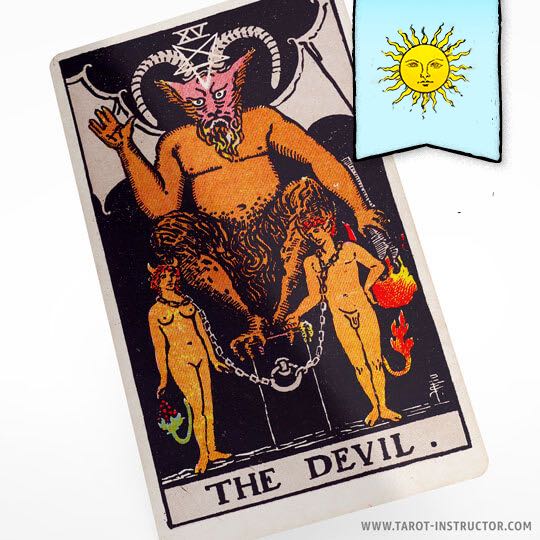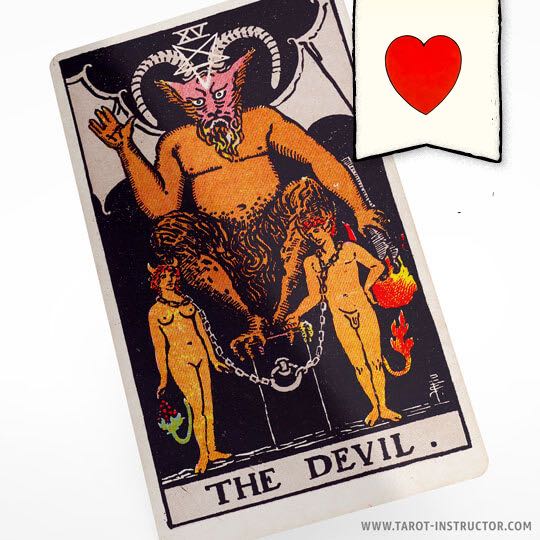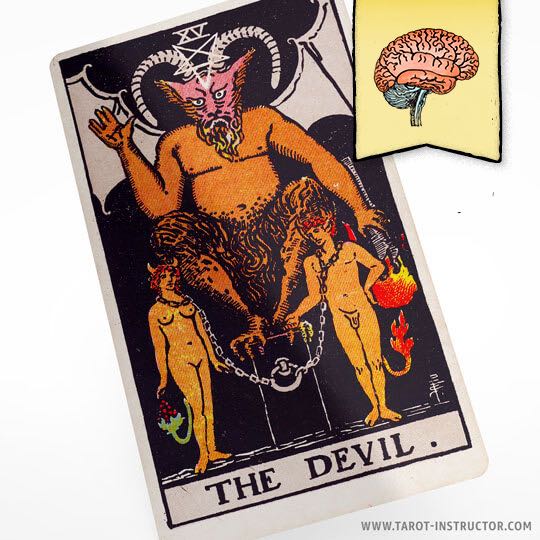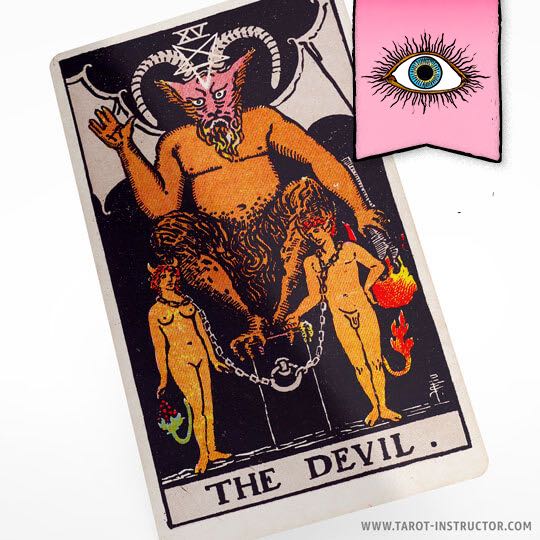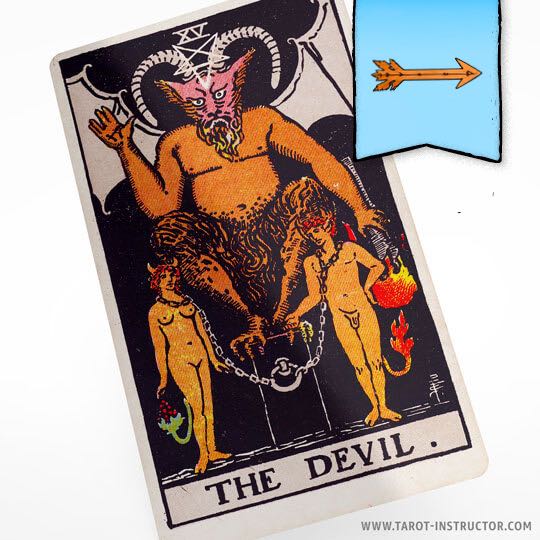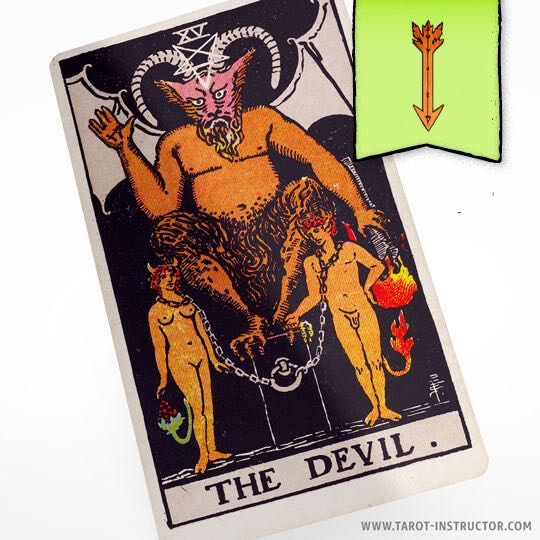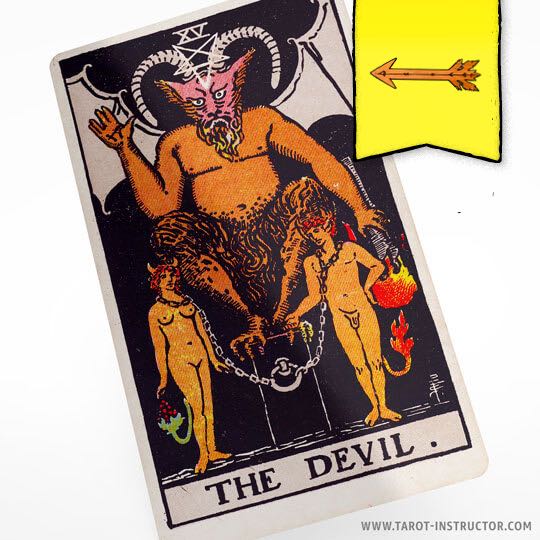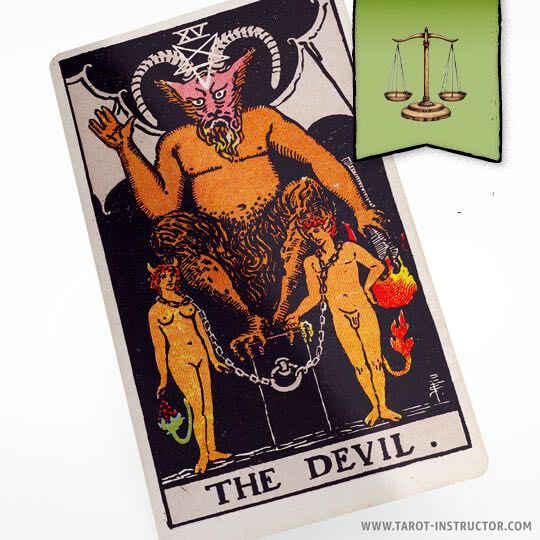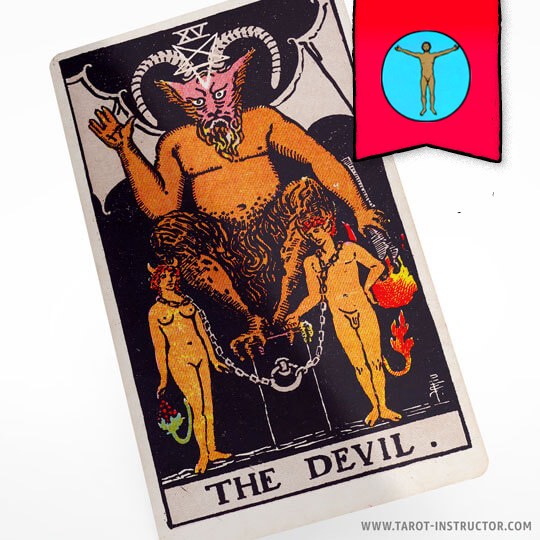The Devil tarot card features following symbolic elements
The Devil tarot card features following symbolic elements
The Devil Figure: Evokes intense attraction driven by desire, hinting at a compelling but possibly toxic bond. Chains: Symbolize feelings of entrapment and dependency, emphasizing the challenge of liberation within the relationship. Fire: Represents fierce passion and desire, suggesting a love marked by both fervor and volatility.
Baphomet: Embodies the duality of love, where pleasure intertwines with pain, revealing complexities in emotional ties. Upside Down Pentagram: Highlights a focus on physical desires over spiritual or emotional growth, indicating a love that may lack deeper fulfillment.
Table of content
The Devil as advice
„Break free from unhealthy attachments.“
The Devil keywords upright
Obsession, Addiction, Dependency, Materialism, Lust.
The Devil keywords reversed
Freedom, Liberation, Release, Overcoming, Choice, Balance.
The Devil card element
Earth
The Devil zodiac sign
Capricorn
The Devil as a Person: Understanding Its Depths
When exploring the symbolism of tarot, each card reveals a story about personality, character, and behavior. Among these cards, the Devil as a person represents temptation, shadow selves, and inner struggles. This article delves into the concept of the Devil as a person, examining what it means when upright and reversed, and how it manifests in both men and women alike.
The Devil as a Person: An Overview
The Devil as a person embodies the darker facets of human nature. It symbolizes temptation, obsession, and the release of inhibitions. When considering the Devil as a person, think of someone who might be caught in cycles of addiction, unhealthy attachments, or power struggles. The Devil as a person is not necessarily evil but represents the shadow side that everyone has to confront.
The Devil as a Person Upright
When interpreting the Devil as a person in the upright position, we see a character often entangled in materialism, desire, or control. This individual might be driven by passions that override reason or morality.
The upright Devil as a person can be someone who exudes confidence but perhaps uses manipulation or coercion to achieve their goals. They may be charismatic yet have a tendency to dominate or entrap others in unhealthy dynamics.
This person might be involved in risky behaviors such as substance abuse, compulsive gambling, or toxic relationships. Their attachment to pleasure or power can lead to self-destructive patterns, making it essential to understand their underlying motivations.
However, the upright Devil as a person also has the potential for awareness and change. Recognizing their shadow traits is the first step toward liberation from bondage and embracing authentic self-awareness.
The Devil as a Person Reversed
In reverse, The Devil as a person often signifies liberation from destructive patterns. This individual might be breaking free from addiction, codependency, or manipulative tendencies.
The reversed Devil as a person suggests someone who is overcoming temptations or reclaiming their personal power. They may have experienced a period of darkness but are now on the path to healing and self-empowerment.
Alternatively, this position can also indicate denial or avoidance. The person might refuse to confront their shadow, hiding from their true nature or refusing accountability.
In this state, The Devil as a person needs to embrace honesty and self-reflection. Letting go of destructive attachments allows genuine growth and freedom.
The Devil as a Man
When considering The Devil as a person in terms of gender, the archetype of the man often embodies temptation, control, and shadow tendencies.
The Devil as a Man Upright
In the upright position, The Devil as a man is charismatic, confident, and often magnetic. He may be someone who seeks power or indulges in pleasures, sometimes at the expense of others.
This man might be involved in manipulative or controlling behaviors—using charm or threats to dominate situations. He could be someone who struggles with addiction or compulsivity, driven by desires that hinder his growth.
He often hides his vulnerabilities behind a mask of confidence, making it difficult for others to see his inner struggles. His journey involves recognizing the shadow side and working toward genuine self-awareness.
While he may seem strong outwardly, the upright Devil as a man can also be a cautionary figure—reminding us that unchecked desire and control can lead to downfall.
The Devil as a Man Reversed
In reverse, The Devil as a man often signifies liberation from unhealthy attachments. This individual might be actively working on overcoming addiction, control issues, or manipulative tendencies.
He could be someone who is reclaiming his personal power and breaking free from toxic patterns. His journey involves honesty, accountability, and self-forgiveness.
However, this position can also indicate a man who is in denial or avoiding facing his shadow. He might be refusing to acknowledge his issues, which can hinder real progress.
In this phase, The Devil as a person needs to explore inner truths and accept responsibility. Self-awareness is key to transforming destructive tendencies into positive growth.
The Devil as a Woman
Turning to The Devil as a woman, this archetype often signifies power, passion, and sometimes, shadow behaviors like obsession or manipulation.
The Devil as a Woman Upright
When upright, The Devil as a woman radiates confidence and magnetic energy. She is often unafraid to confront her desires and may challenge societal norms.
This woman might be passionate, intense, and driven by her goals. She can be a liberator—embracing her sexuality and independence without shame. However, her strength can sometimes turn into possessiveness or controlling behaviors if not balanced.
Her journey involves understanding her shadow side—acknowledging tendencies toward manipulation or obsession—and working toward authentic self-control. She inspires others to embrace their power but also recognizes the importance of responsibility.
The Devil as a Woman Reversed
In reverse, The Devil as a woman often faces struggles with self-control, addiction, or unhealthy attachments. She might be in denial about her shadow traits or refusing to confront her darker impulses.
This phase indicates a need for inner healing and self-awareness. She may be trapped by fears or past traumas that fuel her destructive patterns.
The reversed Devil as a person calls for patience and compassion. Releasing toxic habits and embracing honesty with oneself can lead to liberation and genuine empowerment.
Conclusion
The Devil as a person, whether upright or reversed, offers profound insights into the complexities of human nature. This card embodies temptation, shadow work, and the journey toward self-awareness.
When exploring The Devil as a person, whether as a man or woman, we see that both embody the duality of desire and restraint. The upright symbolizes being entangled in materialism, control, or obsession, while the reversed highlights liberation, healing, and overcoming shadow tendencies.
Ultimately, The Devil as a person teaches us that confronting our inner darkness is essential for growth. Recognizing manipulative patterns or destructive behaviors allows us to reclaim our personal power and live authentically.
Remember, The Devil as a person reminds us that everyone has a shadow side. Embracing it with honesty and compassion is the path toward true freedom and self-empowerment. Facing the challenges of the Devil as a person can lead to profound transformation and inner peace.
Source: Wikipedia The Devil tarot card
Reddit How should the Devil be interpreted?
Quora The Devil card meaning
Tarot Forum The Devil as a Person
Unlock the mysteries of tarot cards.
